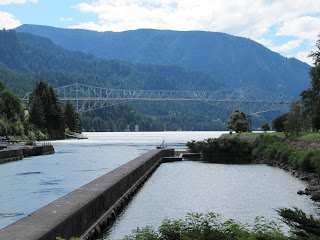 |
| Cascade Locks and Bridge of the Gods |
In the final chapter of her bestselling book, Wild, author Cheryl Strayed ponders her
experiences on the Pacific Crest Trail while enjoying a soft serve cone at the
Eastwind Drive-In at Cascade Locks, Ore. Located 40 miles east of Portland off
Interstate 84, it’s the only town on the trail’s 2600-mile journey from the Mexican
border to Canada, and the spot where the trail crosses the mighty Columbia
River via the Bridge of the Gods.
The town, one of the oldest in Oregon, has long been a
place where travelers needed to come to terms with their plans. An ancient
landslide created a series of whitewater rapids and cascades that served as a
major barrier in the river, forcing a long portage around them. Lewis and Clark described the cascades as
“…water passing with great velocity forming and boiling in a horrible manner…”, and pioneers on the Oregon Trail had to
choose between the hard trek over the Barlow Road, or facing the rapids in a
make-shift raft with the possibility of losing everything.
In 1856, a portage road was built and mules carried
freight around the cascades until they were replaced with the Oregon Pony, the
first steam locomotive to operate west of the Mississippi. The Pony, described
as an “ungainly contraption,” with its tiny engine carried around 200 tons of
freight each day. Passengers rode in one small coach or aboard the flatcars.
+016.JPG) |
| Historical Museum |
The era of portage railroad ended in 1897 when the U.S.
Army Corps of Engineers completed a series of locks to move river traffic
around the cascades. Later, when the Bonneville Dam and Locks were completed
during the New Deal, the waters flooded the old locks leaving only skeletal
stone and concrete outlines, and stairs leading to nowhere. What remains is now a National Historic Site
and can be viewed at the town’s Marina Park, owned and operated by the Port of
Cascade Locks. This attractive, riverside swatch of parkland is also home to
the Oregon Pony which currently resides in its own glass-enclosed and
climate-controlled structure. Next to it,
occupying the former lock tender’s house, is the Cascade Locks Historical Museum
with three floors of artifacts and mementos from the region’s past.
At the east end of the park are statues of Lewis and
Clark guide, Sacagawea, and their canine traveling companion, Seaman. Next door
at the Locks Waterfront Café is the docking site of the Columbia Gorge
Sternwheeler, a three-story replica of the ships that cruised the Gorge in the
1800s. Built in 1983 in Hood River, this 499-passenger paddle
wheeler offers
narrated excursions, brunch and dinner cruises on the river between May and
October.
+006.JPG) |
| Columbia Gorge Sternwheeler |
A few miles downstream is an attraction well worth a
short detour off Interstate 84. While a
working fish hatchery might not be on anyone’s top ten sightseeing list, the
Bonneville Hatchery is located in a pretty, creek side setting with stone
ponds, flowers, tall trees, and neatly manicured grounds, and receives over a
million visitors annually. The hatchery,
opened in 1909, raises fall Chinook salmon, Coho salmon, and summer and winter
steelhead. A self-guided tour leads visitors through the process. In the
historic, wooden Egg Incubation Building, a small museum covers everything
anyone would want to know about salmon and their fascinating life cycle. However,
the biggest and best known attraction at the hatchery is Herman, a 70-year-old,
450 pounds, ten foot
long sturgeon. He and his buddies can be observed through
an underwater, glass window. The adjacent Bonneville Dam and Locks also
welcomes visitors.
+020.JPG) |
| Egg Incubation Building and Museum |
Cascade Locks is the nearest town to a number of popular
Columbia Gorge hiking trails. In
addition to the Pacific Coast Trail, there is access nearby to the Eagle Creek and
Wahclella Falls trails offering some of the Gorge’s most spectacular scenery
and waterfalls. This spring, a new mountain bike trail opened on the east side
of town.
 |
| Herman |

